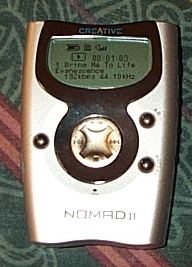 | ||
The NOMAD was a range of digital audio players designed and sold by Creative Technology Limited, and later discontinued in 2004. Subsequent players now fall exclusively under the MuVo and ZEN brands.
Contents
The NOMAD series consisted of two distinct brands:
NOMAD and NOMAD MuVo
These models appear as a USB mass storage device to the operating system so that the device can be accessed like any other removable disk, a floppy disk for example. Older MuVo devices and all Jukebox models use a custom protocol named PDE (Portable Digital Entertainment, a Creative internal device designation) that requires the installation of drivers before the device can be recognised by the operating system.
Creative's foray into the MP3 player market began with the Creative NOMAD, a rebranded Samsung Electronics Yepp YP-D40 player with 64 megabytes of solid-state memory.
IEEE 1284 Parallel port connection
USB 1.1 connection
USB 2.0 connection
NOMAD Jukebox Zen
The first NOMAD Jukebox used the OASiS operating system, which was developed in India. Later NOMAD Jukeboxes used Creative's own firmware. Most players use Texas Instruments TMS320DA25x ARM plus digital signal processor as their CPU and support some version of Creative's environmental audio extensions (EAX).
The NOMAD Jukeboxes have varied in their use of connections. The Jukebox 3 and Jukebox Zen were unusual in their use of the older USB 1.1 standard despite their predecessor, the NOMAD Jukebox 2, having used the newer USB 2.0 standard. Part of the reason for this was the inclusion of a FireWire connection, which is of comparable speed to USB 2.0.
USB 1.1 connection
USB 2.0 connection
A variant of the NOMAD Jukebox was also sold as an OEM product by Dell under the name Dell Digital Jukebox (Dell DJ), a USB 2.0 device. The Second Generation Dell DJ and Dell Pocket DJ 5 are also OEM products from Creative.
Future versions in the Creative ZEN line exclusively use Microsoft's Media Transfer Protocol (also known as PlaysForSure), and some legacy devices have been supplied with firmware upgrades to support MTP. The first NOMAD player and the first NOMAD Jukebox use proprietary protocols, neither PDE or MTP.
Related software
Besides the NOMAD Explorer or MediaSource programs included with the devices, there are other programs which can be used to manage the player and to transfer data.
Bundled software
Free software
For early models
For NOMAD Jukeboxes
libnjb is the driver underlying most of the following programs Amarok is a music player for Linux Banshee is a music player for Linux Gnomad is a Jukebox Manager for Linux Neutrino is another Jukebox Manager for Linux XNJB is a Jukebox Manager for Mac OS X Nomadsync is a Jukebox synchronization tool for both Microsoft Windows and Linux Creative Nomad Jukebox KIO::Slave is an integration driver for KDE JBHTTP is a webserver interface to Jukeboxes that is similar to what Notmad Explorer (see below) did for Microsoft Windows Apple's iTunes [1] is also capable of controlling the Nomad Jukebox.Proprietary software
Notmad Explorer by Red Chair Software is a (now defunct) jukebox management program for Microsoft Windows. The program was notable for fully integrating NOMAD devices into Windows Explorer, providing a web-based interface to the device and providing search capabilities using a built-in SQL database